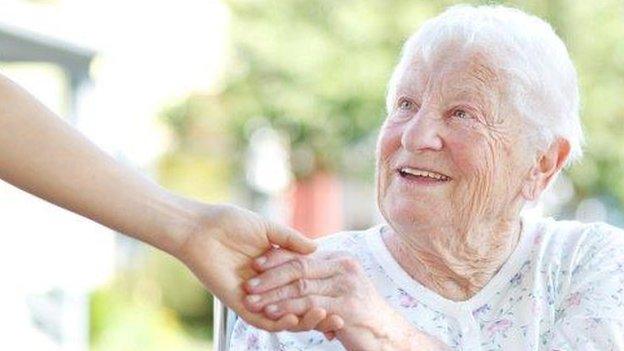Is the cap on care costs doomed?
- Published
- comments

The cap on care costs has been a long time coming. Nearly 70 years in fact, as the social-care system has remained relatively unchanged since the post-World War Two welfare settlement.
But last Friday, in a written ministerial statement, external, the long-awaited changes were put on ice. Instead of the £72,000 cap starting in April 2016, the elderly, and younger adults with disabilities, will now have to wait until 2020.
Unsurprisingly, there is concern in some quarters the delay may actually spell the end for the changes. After all, if a week is a long time in politics - as the saying goes - four years must be an eternity.
Richard Humphries, an expert in social care from the King's Fund think tank, predicts the cap will not now be introduced.
He says: "In four years' time, things will have moved on. Demand will have continued increasing, and there is the National Living Wage to fund. We are now back at the start again, and I can't see it happening."
Officially, the government says it is "firmly committed" to the cap - and certainly it was a manifesto promise. But it would be naive to think there will not be any debate or soul-searching going on inside and outside of government in the coming years over whether the plans are the right ones.
For one thing, there is no guarantee the circumstances that led ministers to announce the delay will be any better by the end of the decade. The government pointed to two main factors.
First, it highlighted the perilous state of council social-care budgets. Care is currently means-tested so the poorest get help towards their costs. What the cap does is mean once spending has reached a certain level, the state will start paying for an individual's care.
This obviously requires there to be a healthy and sustainable council-funded care system to assess people and pick up the extra demand where needed. But this, simply, isn't the case.
The Local Government Association has been getting increasingly vocal about the "huge pressures" its members are facing. Each year, the shortfall was growing by £700m, it said in a letter sent to ministers a fortnight before the announcement, while the numbers receiving help had had to be cut by nearly a third.
To put that in context, the shortfall - in terms of the proportion of the overall budget - is similar to the one facing the NHS, which is to receive an extra £8bn a year by the end of the Parliament.
Councils have not received any such promises. In fact, they are among a number of spending areas being asked to come up with plans for cuts of up to 40% - although for social care there is likely to be a degree of protection as some health funding is being specifically earmarked for care services.
Secondly, the government statement talked about the insurance market not developing "as expected".
This is important. The thinking behind the cap was that it would encourage the public to start planning for their care and entice the insurance industry to offer products - safe in the knowledge that the catastrophic costs would be picked up by the state.
But it hasn't happened. A survey by the BBC published in January found none of the leading insurance companies had plans for care products.

How the care system works

People have to pay for their elderly care whether that's round-the-clock help in a care home or support with tasks such as washing and dressing in their own home
Currently, only those with low means - under £23,250 in savings and, in some cases, the value of a home - receive help towards their costs
The rest have to pay all their care costs. For one in 10, these can exceed £100,000
The government has proposed capping lifetime costs at £72,000 from the age of 65 onwards. Although, this does not cover living costs for things such as food, bills and accommodation, for which people will still be liable to the tune of £230 a week
The cap also applies to disabled 25- to 65-year-olds, although much of the attention has been on older people as they tend to be the ones who have built up the assets to face the biggest care costs
Find out more

One of the main reasons given for this is that the cap may have been too high. At £72,000 the belief is that it failed to get enough people thinking differently about their care. Without public demand, the insurance industry hasn't got on board.
That is why, when the delay was announced last week, Age UK was quick off the mark, arguing that the level of the cap needed to be looked at.
But don't be surprised if that debate extends to the whole policy. The cap - along with other measures that accompanied it - was expected to have cost in the region of £6bn over the next five years.
Some in local government have privately questioned all along whether, if that amount of money is to be put into the system, the best use of it is something that limits the liabilities of the wealthier groups in society.
April 2020 - the new date for implementation - will, in all likelihood, be just a few weeks away from a general election. It will mean the Tories will have been in power for nearly a decade yet still be trying to implement a tricky reform that was on the agenda when they first took office.
Something similar happened with Labour. When he came to power in 1997, Tony Blair was talking about changing the system, but it was not until the final months of the Gordon Brown government in 2010 that firm plans were put forward, only for the cut and thrust of the election campaign - the Tories dubbed them a "death tax" - to scupper them. Could history be about to repeat itself?